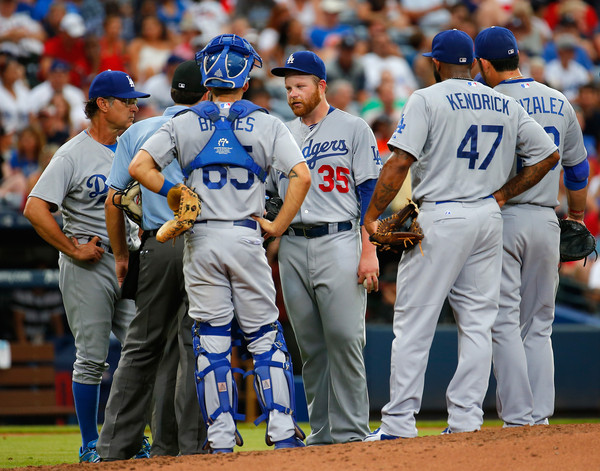This is Part 1 in a series in which every member of the 2015 Dodgers has his season juxtaposed with an episode of the greatest sitcom of all-time. Don’t take it too seriously.
Fifty-five different players played at least one inning for the 2015 Dodgers. There are 172 different episodes of the sitcom Seinfeld, or 180 if you break up the one-hour episodes into two half-hour segments, like the basic cable channels do now that the series is in syndication.
You might not like Seinfeld, or the 2015 Dodgers, but with so many players and episodes to choose from, some entertaining combinations are sure to follow. So, in our quest to keep a review of each player’s season both insightful and light-hearted, we present an alphabetized Season in Review About Nothing. (Seinfeld was once famously dubbed a “show about nothing” … in an episode of Seinfeld.)
Brett Anderson, LHP.
Key stats: 31 regular-season starts, 10-9 record, 3.69 ERA, 3.94 FIP, MLB-leading 66.3 percent ground-ball rate.
Seinfeld episode: The Andrea Doria (season 8, episode 10).
Key quote: “Yes, but, you see – Mister Eldridge is an Andrea Doria survivor. And, in light of the terrible suffering that he’s already been through, we’ve decided to give [the apartment] to him.”
In six major-league seasons prior to signing with the Dodgers, Anderson had made 30, 19, 13, 6, 16 and 8 starts. That’s a wide range of expectations for a pitcher who rarely stayed healthy for long, and Anderson exceeded all of them. The Dodgers gave the 27-year-old left a base salary of $10 million for one year plus $4 million in incentives. He earned $2.4 million by pitching 180 ⅓ innings. In retrospect, Anderson’s contract might have been the best gamble the Dodgers made last winter.
Penciled in as the number-5 starter coming out of spring training, Anderson’s 2015 numbers would be stellar for any number-5. Yet by the end of April, Hyun-Jin Ryu and Brandon McCarthy had both been dealt season-ending injury diagnoses. Anderson’s good health was no longer a mere bonus. It was a necessity for the Dodgers’ decimated rotation.
And that’s what makes Anderson’s 2015 season such a difficult body of work to evaluate. In the context of his career, it was his masterpiece. Anderson had never avoided the 60-day disabled list for a full season since his rookie year of 2009. He’d never made more than 30 starts, or pitched more than 180 innings. He’d never been in position to attain a $15.8 million salary over a full year, let alone hold out for a better offer. When the Dodgers gave him a qualifying offer last Friday, that’s exactly where Anderson found himself. It’s a nice problem to have.
In the context of what the Dodgers ultimately needed from Anderson in 2015, they probably could have asked for more. For once, his health wasn’t the issue. Anderson’s injuries were minor: A calf muscle in September, inflammation in the sheath around his Achilles tendon in August. Anderson’s problem was an external one: in a rotation anchored by Clayton Kershaw and Zack Greinke, Anderson’s shortcomings stood out. His 17 percent home run-to-fly ball ratio factored into several Dodgers losses. Anderson made 18 quality starts; Greinke made 30.
When the front office failed to bolster the rotation with a suitable number-3 starter, Anderson was thrust into a National League Division Series matchup at Citi Field against Matt Harvey. The Dodgers scored seven runs in that game, as many as any opponent scored in the Mets’ 14 postseason games. They still lost. Having blown through his career high in innings pitched, Anderson allowed six runs in three innings. He turned the ball over to Alex Wood, the best pitcher the Dodgers got at the deadline, and the game became even more out of hand. It was the Dodgers’ trade deadline in a nutshell — a bad thing at a bad time.
But if you look at what Anderson did in a vacuum, the Dodgers couldn’t complain. Whether or not Anderson accepts the qualifying offer, it’ll be an interesting decision either way.
The closest thing Seinfeld has to offer to the plight of an oft-injured pitcher like Anderson is “The Andrea Doria,” an episode in which a coveted Manhattan apartment is given to the prospective tenant with the most pitiful life story.
Anderson’s injury history contains some comic elements: breaking his hand after being hit by a pitch while squaring to bunt, jogging off the mound and injuring an Achilles’ tendon sheath, etc.
George Costanza should have been so lucky. He didn’t get the apartment — Elaine’s boyfriend did after she stabbed him with silverware — but Anderson got one nice payday, followed by another.

